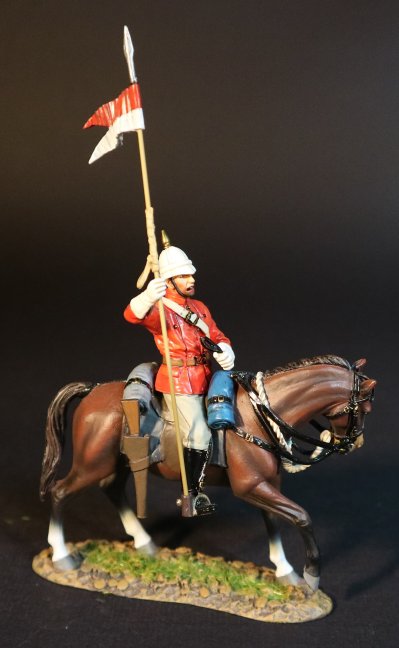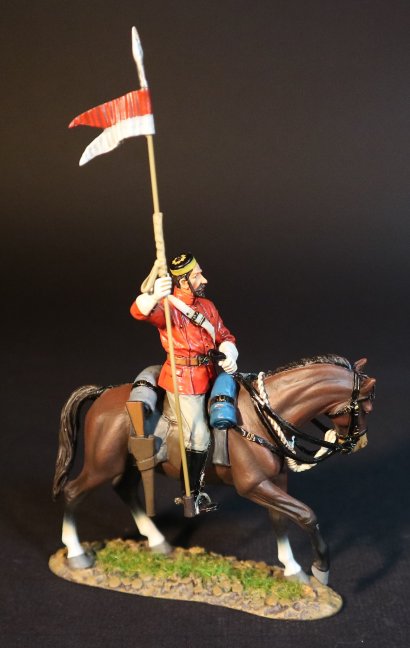- Joined
- Feb 2, 2011
- Messages
- 2,093
NEW RELEASES FOR DECEMBER 2023
THE FUR TRADE
MOUNTAIN MEN - THE RENDEZVOUS
A mountain man was an explorer who lived in the wilderness. They were instrumental in opening up the various Emigrant Trails (widened into wagon roads) allowing Americans in the east to settle the new territories of the far west by organized wagon trains traveling over roads explored and in many cases, physically improved by the mountain men and the big fur companies originally to serve the mule train based inland fur trade.
Mountain men were most common in the North American Rocky Mountains from about 1810 through to the 1880s (with a peak population in the early 1840s). Approximately 3,000 mountain men ranged the mountains between 1820 and 1840, the peak beaver-harvesting period. While there were many free trappers, most mountain men were employed by major fur companies. The life of a company man was almost militarized. The men had mess groups, hunted and trapped in brigades and always reported to the head of the trapping party.
This man was called a "boosway", a bastardization of the French term bourgeois. He was the leader of the brigade and the head trader.

The Rendezvous was an annual gathering, at various locations held by a fur trading company at which trappers and mountain men sold their furs and hides and replenished their supplies.
Held every summer, the trappers came together for the Rendezvous (pronounced “Rondy-Voo”) It was a celebration like Christmas, New Year’s Eve and the Fourth of July all rolled into one.
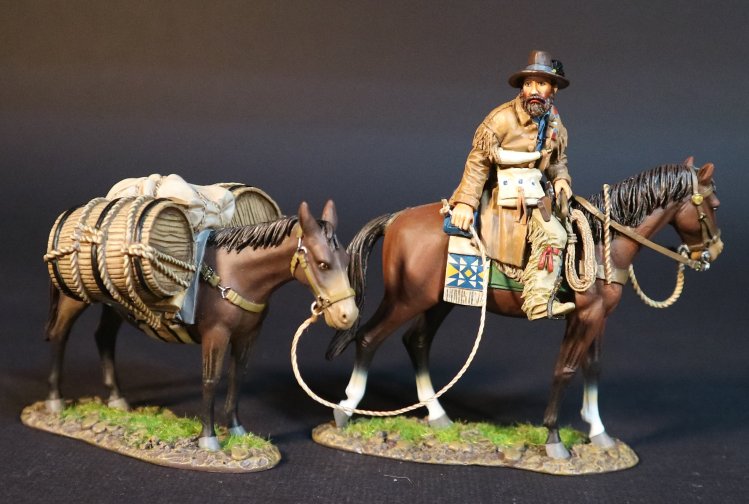
WSP-43
THE FUR TRADE,
THE MOUNTAIN MEN,
TEAMSTER WITH WHISKY MULE.
(3 pcs)
The large fur companies put together teamster driven mule trains which packed in whiskey and supplies into a pre-announced location each spring/summer and set up a trading fair- the Rendezvous.
Not only was the Rendezvous a place where the trappers could sell and trade their furs for all sorts of commodities, such as clothing, saddles, bridles, tobacco, and whiskey, but it was a place to meet traders who might wish to engage their services for the coming year.
These Rendezvous were known to be lively, joyous places, where all were welcome, fur trappers, Indians, native trapper wives, and children, travellers, and even tourists who would venture from as far as Europe to observe the festivities.
By the mid-1830s, the annual event would attract up to 500 men.
They were described as events “full of myrth, songs, dancing, shouting, trading, running, singing, racing, target-shooting, yarns, frolics, with all sorts of extravagances that white men or Indians could invent!”
These events include many of the activities that were necessary for survival, centering on shooting, guns and shotguns; throwing knives and tomahawks; primitive archery; as well as cooking, dancing, singing, the telling of tall tales and of past rendezvous.
CROW WARRIOR SCOUTS
Scouts were valued because of their specialized skills and knowledge acquired over a lifetime: knowledge of how to follow a trail and observe the enemy without being seen, knowledge of the country, and ability to identify vital information from tracks. These skills made it possible for soldiers operating in an alien environment to locate and surprise elusive enemies in their own country and greatly enhanced the ability of the military to carry out their mission.
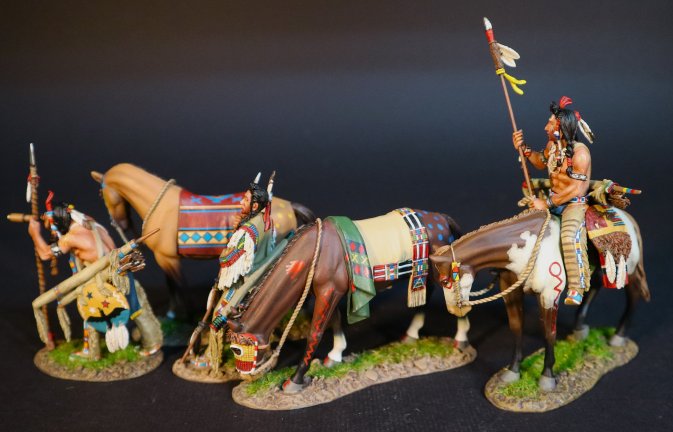
Recruitment of Indian scouts was first authorized on July 28, 1866 by an act of congress.
"The President is authorized to enlist and employ in the Territories and Indian country a force of Indians not to exceed one thousand to act as scouts, who shall receive the pay and allowances of cavalry soldiers, and be discharged whenever the necessity for further employment is abated, at the discretion of the department commander.”
In the Indian wars following the U.S. Civil War, the Indian Scouts were a fast-moving, aggressive, and knowledgeable asset to the U.S. Army. They often proved to be immune to army notions of discipline and demeanor, but they proved expert in traversing the vast distances of the American West and providing intelligence—and often a shock force—to the soldiers who sought hostile Indians.
During the Indian wars, scouts were able to detect horse tracks where other soldiers could only detect hard ground. From these tracks, scouts could estimate the number of horses in a group. From the moisture content of horse dung, scouts could estimate the age of the trail. Scouts were also able to discern whether females rode with a group based on the position of a horse's urine within its tracks - women sometimes/often rode mares while men rode stallions.
One of the most notable U.S. Army Indian Scouts was “Curley”, a member of the Crow tribe who became a scout in April 1876 under Colonel John Gibbon. He then joined Lieutenant Colonel Custer.
Curley is most often identified as the lone survivor of “Custer’s Last Stand”.
He denied witnessing the battle, although the Chicago Tribune published an article claiming that Curley had made statements to them about the battle.
John F. Finerty claimed that “Curley said that Custer remained alive throughout the greater part of the engagement, animating his men to determined resistance, but about an hour before the close of the fight received a mortal wound”.
Signals were done in many ways, there were arm or hand signals, holding a lance, gun or robe. Mirrors or whistles were also used. There were two kinds of signals employed on the plains, those designed for close quarter communication, and those designed for signaling over long distances of a mile or more.
There were 3 long distance methods. The Body action, the action of the signaler in connection with objects, such as a robe, blanket, mirror, flag, lance or by smoke.
Smoke or mirror signals were used in daytime, with the number of flashes or puffs serving as a kind of morse code, and fires placed at intervals in rows accomplished the same thing at night.
Smoke signals were made by letting the smoke rise in a single column, or by slipping a robe or blanket sideways over a fire made with dry wood and green grass or moss thrown on it.
Fire signals were made on high ridges or away from water so that it would be known they were not campfires.
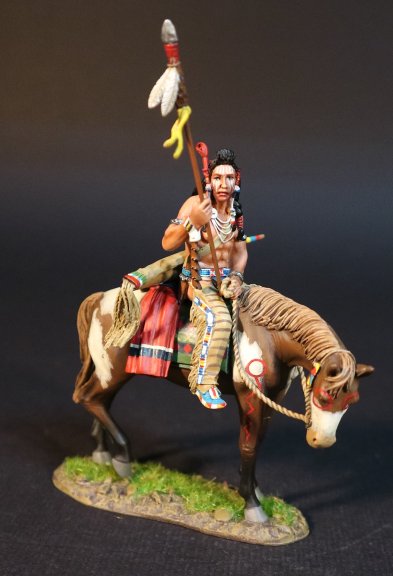
WSP-08C
THE FUR TRADE,
THE CROW,
CROW WARRIOR SCOUT.
(3 pcs)
THE FUR TRADE
MOUNTAIN MEN - THE RENDEZVOUS
A mountain man was an explorer who lived in the wilderness. They were instrumental in opening up the various Emigrant Trails (widened into wagon roads) allowing Americans in the east to settle the new territories of the far west by organized wagon trains traveling over roads explored and in many cases, physically improved by the mountain men and the big fur companies originally to serve the mule train based inland fur trade.
Mountain men were most common in the North American Rocky Mountains from about 1810 through to the 1880s (with a peak population in the early 1840s). Approximately 3,000 mountain men ranged the mountains between 1820 and 1840, the peak beaver-harvesting period. While there were many free trappers, most mountain men were employed by major fur companies. The life of a company man was almost militarized. The men had mess groups, hunted and trapped in brigades and always reported to the head of the trapping party.
This man was called a "boosway", a bastardization of the French term bourgeois. He was the leader of the brigade and the head trader.

The Rendezvous was an annual gathering, at various locations held by a fur trading company at which trappers and mountain men sold their furs and hides and replenished their supplies.
Held every summer, the trappers came together for the Rendezvous (pronounced “Rondy-Voo”) It was a celebration like Christmas, New Year’s Eve and the Fourth of July all rolled into one.

WSP-43
THE FUR TRADE,
THE MOUNTAIN MEN,
TEAMSTER WITH WHISKY MULE.
(3 pcs)
The large fur companies put together teamster driven mule trains which packed in whiskey and supplies into a pre-announced location each spring/summer and set up a trading fair- the Rendezvous.
Not only was the Rendezvous a place where the trappers could sell and trade their furs for all sorts of commodities, such as clothing, saddles, bridles, tobacco, and whiskey, but it was a place to meet traders who might wish to engage their services for the coming year.
These Rendezvous were known to be lively, joyous places, where all were welcome, fur trappers, Indians, native trapper wives, and children, travellers, and even tourists who would venture from as far as Europe to observe the festivities.
By the mid-1830s, the annual event would attract up to 500 men.
They were described as events “full of myrth, songs, dancing, shouting, trading, running, singing, racing, target-shooting, yarns, frolics, with all sorts of extravagances that white men or Indians could invent!”
These events include many of the activities that were necessary for survival, centering on shooting, guns and shotguns; throwing knives and tomahawks; primitive archery; as well as cooking, dancing, singing, the telling of tall tales and of past rendezvous.
CROW WARRIOR SCOUTS
Scouts were valued because of their specialized skills and knowledge acquired over a lifetime: knowledge of how to follow a trail and observe the enemy without being seen, knowledge of the country, and ability to identify vital information from tracks. These skills made it possible for soldiers operating in an alien environment to locate and surprise elusive enemies in their own country and greatly enhanced the ability of the military to carry out their mission.

Recruitment of Indian scouts was first authorized on July 28, 1866 by an act of congress.
"The President is authorized to enlist and employ in the Territories and Indian country a force of Indians not to exceed one thousand to act as scouts, who shall receive the pay and allowances of cavalry soldiers, and be discharged whenever the necessity for further employment is abated, at the discretion of the department commander.”
In the Indian wars following the U.S. Civil War, the Indian Scouts were a fast-moving, aggressive, and knowledgeable asset to the U.S. Army. They often proved to be immune to army notions of discipline and demeanor, but they proved expert in traversing the vast distances of the American West and providing intelligence—and often a shock force—to the soldiers who sought hostile Indians.
During the Indian wars, scouts were able to detect horse tracks where other soldiers could only detect hard ground. From these tracks, scouts could estimate the number of horses in a group. From the moisture content of horse dung, scouts could estimate the age of the trail. Scouts were also able to discern whether females rode with a group based on the position of a horse's urine within its tracks - women sometimes/often rode mares while men rode stallions.
One of the most notable U.S. Army Indian Scouts was “Curley”, a member of the Crow tribe who became a scout in April 1876 under Colonel John Gibbon. He then joined Lieutenant Colonel Custer.
Curley is most often identified as the lone survivor of “Custer’s Last Stand”.
He denied witnessing the battle, although the Chicago Tribune published an article claiming that Curley had made statements to them about the battle.
John F. Finerty claimed that “Curley said that Custer remained alive throughout the greater part of the engagement, animating his men to determined resistance, but about an hour before the close of the fight received a mortal wound”.
Signals were done in many ways, there were arm or hand signals, holding a lance, gun or robe. Mirrors or whistles were also used. There were two kinds of signals employed on the plains, those designed for close quarter communication, and those designed for signaling over long distances of a mile or more.
There were 3 long distance methods. The Body action, the action of the signaler in connection with objects, such as a robe, blanket, mirror, flag, lance or by smoke.
Smoke or mirror signals were used in daytime, with the number of flashes or puffs serving as a kind of morse code, and fires placed at intervals in rows accomplished the same thing at night.
Smoke signals were made by letting the smoke rise in a single column, or by slipping a robe or blanket sideways over a fire made with dry wood and green grass or moss thrown on it.
Fire signals were made on high ridges or away from water so that it would be known they were not campfires.

WSP-08C
THE FUR TRADE,
THE CROW,
CROW WARRIOR SCOUT.
(3 pcs)



